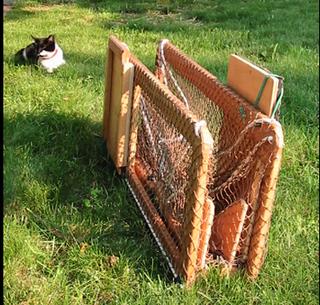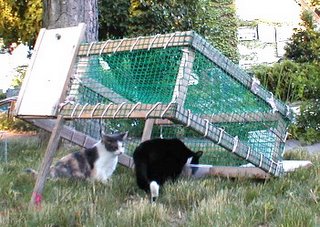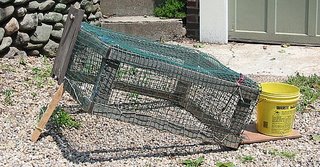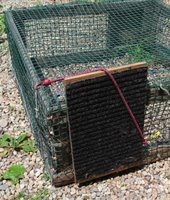
Drop Trap: User’s Manual
(this was written for the HubCats version, but most is applicable to any drop trap)
You will need:
1. An appointment at the vet, for surgery the following day. Cats should be fasted over night prior to surgery.
2. The drop trap and a cover (double size sheet or blanket) for it
3. The stick-and-string, and an anchor weight (eg. a bucket with bricks OR patio block).
4. Bait food and a deep unbreakable dish.
5. One or more wire box traps or transfer cages (one per cat) with guillotine doors in addition to the trap door. Covers for these traps.
**WARNING**: The drop trap isn’t foolproof. Cats can escape at various points in the process, but careful technique can avoid most disasters. Practice this procedure several times, and DON’T use the drop trap for the first time on a cat you’ve been trying to get for 3 years. You’ll make mistakes at first, you’ll lose a few, and you don’t want it to be THAT one. Once you think you’ve got the hang of it, you might trap a few eartipped cats for practice (you can update their rabies vaccines, or just thank them and release them).
Quickie Directions
1. Set up in a good location (where you can see, and the ground is level), door facing your position (the spot where you will be watching from), if possible.
2. Place a plentiful amount of food in the center-back of the trap.
3. Leave some wire box traps and covers where you can reach them from the drop trap.
4. Stand back a good distance (depends on the cats) with an unfolded blanket, holding the cord. Take up the slack. Ask observers to stay back unless you call them.
5. When cat or cats **have settled down** to eat at back of trap, give the cord a good yank
6. Run or walk up to the trap and COVER COMPLETELY. This is important if they’re very wild! If you’re alone, hold the trap down firmly and wait for them to settle before you attempt the transfer.
7. You want to get the cat(s) out as quickly and quietly as possible, and reset the trap.
8. Line up the box trap, door to door, to receive cat, and cover it with a towel. DON’T cover the far end of the trap – you want it to look like an exit. Don’t let helpers stand there, either. CAREFULLY arrange towel and blanket to cover gaps between the two traps, place your foot on the box trap to keep it from shifting -- and open both doors. Stand very still -- don’t talk.
9. If he doesn’t move into the box trap in 15 seconds, twitch the cover or call a helper, to stand behind the droptrap and motivate the cat to move towards you and enter the box trap. Keep the cover between you and the cat so he doesn’t see you.
10. Close BOTH doors when cat has entered box trap. If there are other cats remaining in the drop trap, you’ll transfer them one at a time, generally.
11. Cover and remove cat to some distance if he’s the only one, if there are others, just put him aside while you transfer the others. Then reset the trap and get them away.
12. Inspect the cat in the box trap at your leisure to be sure he/she is not eartipped or nursing kittens you don’t know about.
Tips and Techniques
Choosing a site and Setup
1. You’ll generally put the trap in the area where the cats are used to finding food. Set up the drop trap where you’ll be able to see it well! Try to site the trap where you’ll have a good view of the general area around it, so that you don’t drop it just when a second cat is lurking nearby, thinking about entering. Also, since you’re in control of the trap, you’ll want to see eartips, etc. A super-bright flashlight (or car headlights) work fine at night to spotlight the trap. Cats don’t seem to be concerned by lights.
2. A car is a good place to hide while waiting, especially if it’s cold and windy, if you can park within view of the trap. If the cats are particularly wary, you might park facing away from the trap, where you can see in your rearview mirrors. In general, people in cars are invisible to cats, and cars are not considered alarming.
3. Try not to make multiple trips back and forth with trap, bucket, food, etc. Cause as little commotion as possible.
4. Lay the trap down first, to be sure that when the trap is dropped, that there are no gaps or objects that interfere with its dropping.
5. Place it as close as possible to where they’ll expect to find food – this saves time. If you can, set it next to a wall or porch railing to restrict entry to one side. This enables you to place the food further away from the available side, which means they’ll be farther into the trap when eating. Remember to leave room for placing a box trap in front of the sliding door.
6. Orient the trap, so that the front (the side with the door) is facing you. This means that the cat will have to turn her back to you, to eat (and won’t see your motions). If this is not possible, put the prop-stick on whatever side IS facing you – it may jam otherwise, and not come immediately when you pull on the cord.
7. Put a trap or traps (and covers) near the trap so they’re easily accessible when there’s a cat or two in the trap. Once the drop trap is covered, the cats will generally be quiet enough for you to go grab another box trap. Sometimes the unfamiliar smell of your traps and/or covers will be too distracting to the cats. If so, keep the traps where you are standing, and bring one with you when you’ve sprung the trap.
Bait
1. Use a deep, unbreakable dish (I like the Gladware Large Rectangle), or a dish familiar to them. Ideally, you want a dish large enough that two or more can eat simultaneously. A weighted, non-skid pet dish is good, to avoid spills.
2. Supply enough food for several cats to come and eat their fill (if there’s more than one cat in the area). Even if they’re not the cats you want, they are useful as decoys to assure the others that it’s safe to eat – and that the food’s good! You don’t want to run out of food before your target kitty enters the trap.
3. If possible, use their usual food, especially if they’re suspicious of anything new. I use Friskies wet food mixed into a good quality dry food, unless they’re the suspicious types. Remember, unless there’s only one cat in the area, you want to put down plenty of food. They may associate tuna with trapping if you’ve trapped their colony a lot. You’ll figure this out from their reactions.
4. Put the food ONLY in the center-back of the trap to keep the cats as far as possible from any outside edge of the trap. If the trap is up against a wall or fence, limiting access to one side, you can put the food closer to the wall/fence – this puts the cats even farther from the edges of the trap.
5. If they don’t seem to realize that there’s food in the container, if they’re not used to scavenging for food (because they’re so spoiled or they’re young kittens), or they are very wary, or if you’re using bait that’s unfamiliar to them, you may need to leave a sprinkling of food (free samples) around and in the trap. The empty can of cat food left near the trap is a visual cue that they will be familiar with, and be attracted to.
Dropping the trap
1. WAIT UNTIL THEY’VE SETTLED AT THE BACK OF THE TRAP TO EAT. If you wait too long, or if they’re a little nervous and they leave quickly, they’ll COME BACK sooner or later – they know there’s food there. Don’t make the mistake of dropping it before they’re settled at the back of the trap, and have them squeeze out! You’ll have made that cat MORE wary, and s/he will be harder to trap. If there are 2 eating and 1 is waiting (but inside the trap), wait until they’ve ALL started eating, or one leaves, or you’re taking a chance that you’ll lose one.
2. If other cats are watching when you drop the trap, they’ll scatter when the trap comes down (or when you approach). Don’t worry, they’ll be back. They won’t understand that you’ve taken the cats inside, away, they’ll think – oh great – now it’s my turn to eat.
3. Don’t worry too much about dropping the trap on a tail that’s left under the edge of the trap, as long as the owner of the tail is eating at the back of the trap. Once the trap starts to move, the cat will move.

Transferring a cat from the drop trap to a box trap
Don’t do your victory dance until the cat has been safely transferred to the box trap.
Tell observers to STAY BACK unless you call them for assistance -- avoid getting distracted.
Sometimes the transfer from the drop trap to the box trap takes a minute or two. Don’t panic, be patient. It takes a few seconds in most cases, but it can take longer (or seem longer).
1. Take the time to cover the gap between the traps with the towel and cover. Put your foot on the box trap to keep it from shifting. Focus yourself, then open the two doors, together.
2. The cat may not notice the open door right away.
3. Give him 20 seconds or so to see the open door. He should calm down slightly (or not). You might try closing and re-opening the wooden door, and that may get his attention. Sometimes it helps to twitch the cover slowly towards you and away from the back of the trap; the cat may move towards the front as he attempts to stay under cover. (Don’t let him see you and realize he’s also moving towards you). But, sometimes he redoubles his effort to get out of the back of the trap when the back is uncovered.
4. If the cat is determined to get out one of the far sides of the trap, it helps to have a helper (any observer). Ask them to get DOWN, face to face with the cat (not hover overhead which just frightens them and doesn’t give them direction.) Assuming that the cat can’t see where you are standing at the front of the trap because of the trap cover, the cat will turn away from the helper and run toward the “exit”.
5. If you don’t have a helper, just re-cover the trap and try again. He’ll go in eventually. Just be patient, stay calm and quiet. I don’t talk to them generally – I want them to forget that I’m standing there, since I want them to come towards me and into the box trap.
6. You’ll see him pass into the box trap between the two covers. He may hurl himself with a lot of force at the end of the box trap thinking he can get out that way – be sure that he doesn’t shift the trap too much, increasing the gap between the two traps. Quickly push down the WOODEN DOOR completely, it works more smoothly than the box trap door. As long as the trap doesn’t shift position, he can’t get out (and he’ll be at the far end of the trap anyway). If there’s a second cat in the drop trap, you must close the wooden door before you move the box trap away, or the second cat will escape. Keep the trap from shifting to the side (helper or foot), until you can also get the box trap door down. Now arrange the towel to cover the trap and take him away.
7. Once in a while, especially with semi-tame cats and young kittens, the cat will settle down in the middle of the drop trap, and won’t leave. Having a can of compressed air (available in office supply places, for cleaning keyboards) is useful for these occasions – give him a few poosts from the back of the trap, with the back and top of the trap exposed (it really helps to have a helper work the doors). Sometimes turning the trap may help – you may be asking him to run towards the house, and he may want to run toward the woods, for example. Sometimes a broom slipped under the edge of the trap will spook them sufficiently to move them, but it’s risky to lift the trap.
If you blow it
If the cat escapes at some point in the process, it’s not necessarily a fatal error. Cats sometimes wiggle out of the trap, only to come back the same day, within an hour or two, to try again. You’ll need to allow the cat to see the trap, and her friends eating from it for some period of time (short or long, depending on the cat) before she’ll re-enter it. In this case, I would not drop the trap again, until you get the cat that escaped. The cats that eat uneventfully from the trap in the meantime will enter it again AFTER you’ve trapped this cat.
Strategy
If you’re used to trapping with box traps, there are a couple of differences, using the drop trap.
1) You are in control of the trap. You want all the cats to eat from the drop trap. If they’ve already been neutered, they’ll serve as good decoys to reassure your target cats – don’t try to keep these cats out of the drop trap by feeding them elsewhere.
2) You don’t have to withhold food for long periods, since cats are less suspicious of the drop trap. If you have a cat that refuses to enter the drop trap, and there are no other cats around to demonstrate its “safety”, you’ll probably have to leave the trap, and feed only in the trap for a few days, before making the attempt.
CAUTION: If you must leave the drop trap unattended, DISABLE IT by taking the stick and string with you, and by removing the door. You don’t want the trap to come down and trap a cat (either by itself or due to another person’s interference) when you’re not there. Prop the trap securely on a bucket, or milk crate – anything stable, and about the height of the prop stick.
· If there’s a cat that’s particularly jumpy, wary, or pregnant, I like to catch her first, and not do anything that will confirm her suspicions, until she’s safely out of the way. However, if she’s not around, go ahead and catch the others. Cats that eat safely from the trap will return and you can get them another day. If there’s a momcat and kittens younger than 3 months, I try to get kittens first, unless they all eat together, and I can get them at once. Kittens 3 months and older are probably okay without mom - if you want to trap her first. Remember that she should be coming right back in a couple of days, after her spay.
· When one cat finishes eating, there’s a delicate moment when one of the other cats who has been observing, will suddenly make up their mind to try out this new thing. If that is your target cat, you don’t want her to discover that the dish is empty, or have to run in at that point to adjust something. If you need to adjust the drop trap somehow, or get a better look at the cat who’s in it, add more food or check the food, it’s better to approach the trap casually when the first cat is still in there, they’ll scatter, but they’ll be back as soon as you leave and will generally take up where they left off.
· Sometimes, you’ll want to “shuffle the deck” for some reason – for example, if a target cat is in the trap along with a cat you don’t want to trap just yet (a mom with young kittens, for example). Approach the trap casually, until they scatter. When they return, you may have a better shot at your target cat.

Addendum: The Fold-O-Matic drop trap
Setting up the Fold-O-Matic
1. Open it like a lawn chair – hold the two ends about waist high, and spread apart. The folding arms will SNAP open – don’t get in their way!
2. Release the anchor flap and set a weight on it (a bucket of bricks, or similar). This anchor will hold the trap down, making it stable when propped, and will keep the trap somewhat anchored when there are cats banging around inside. If you hold the front corner down as well, the trap will be secure.
3. Place the food inside, center-back, then prop the front.
Folding
1. Remove the prop stick.
2. Stow the anchor flap.
3. Lean the trap onto its back end. While holding the front end, push in the folding arm with your knee (don’t use your fingers – they could get pinched!). Gently set the front end down on that side, and repeat with the other side.
Storing and Transporting
1. I would strongly recommend that you keep it DRY, and STORE IT out of the sun (the netting may rot and weaken after long exposure to sunlight).
2. It would be wise to find a bag, case or box – or wrap it in a sheet - to protect the netting from getting caught on the sharp edges of box traps, during transport.
Customer Service, Repair, Complaints and Suggestions
Laura Burns
HubCatsBoston@aol.com
585-787-4209
 A drop trap is a lightweight frame covered with netting - made to catch feral cats. It is propped up in front with a stick, and food is placed in the back. The trapper stands at a distance, holding a string attached to the stick. When the cats are eating, the trapper pulls the string, allowing the trap to drop, capturing the cats inside. The trapper immediately covers the drop trap with a blanket to calm the cat(s).
A drop trap is a lightweight frame covered with netting - made to catch feral cats. It is propped up in front with a stick, and food is placed in the back. The trapper stands at a distance, holding a string attached to the stick. When the cats are eating, the trapper pulls the string, allowing the trap to drop, capturing the cats inside. The trapper immediately covers the drop trap with a blanket to calm the cat(s). The transfer: The cats are easily transferred into traditional box (wire) traps for transport. A box trap is placed door-to-door with the covered drop trap. The box trap is also covered (top and sides only) to make it appear to be an exit tunnel. When the matching guillotine-style doors are raised, the cats discover the “exit” and move into the box trap, for secure transport to the vet!
The transfer: The cats are easily transferred into traditional box (wire) traps for transport. A box trap is placed door-to-door with the covered drop trap. The box trap is also covered (top and sides only) to make it appear to be an exit tunnel. When the matching guillotine-style doors are raised, the cats discover the “exit” and move into the box trap, for secure transport to the vet!











.jpg?t=1458514336)


.jpg?t=1458888624)






